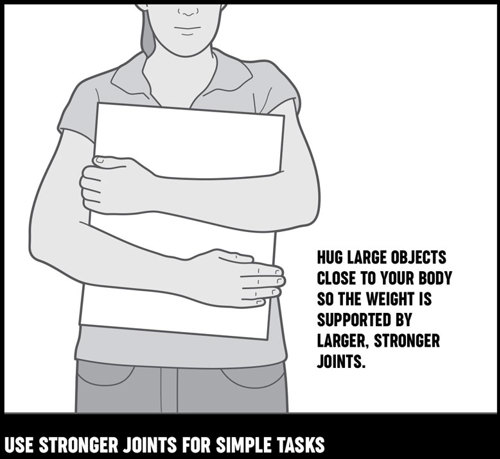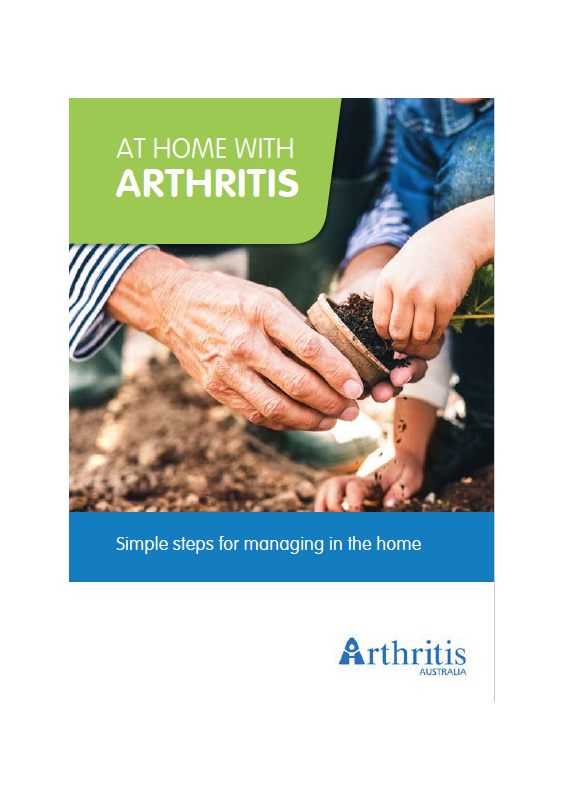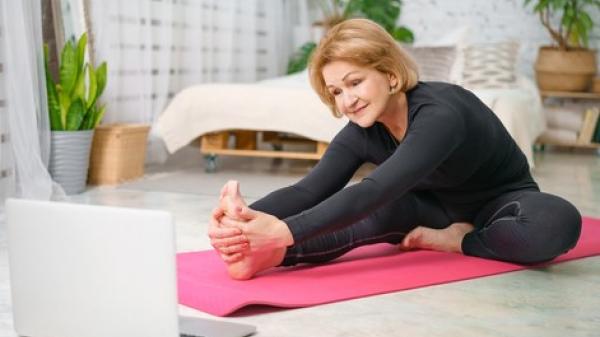
When you have arthritis, joint pain and weakness can make normal activities around the home difficult. You might find some tasks cause pain or strain, and other activities become almost impossible. But don’t give up just yet! There are many ways that you can protect your joints from pain and strain and make jobs around the home easier to manage.
This information and and more can be found in Arthritis Australia's At home with arthritis: simple steps for managing in the home.
Protecting your joints
Joints affected by axSpA are usually weaker and less stable than ‘normal’ joints. This makes them more vulnerable to damage, particularly from twisting or repetitive movements. As soon as you find out you have axSpA, it is important to start looking after your spine and joints. Small changes in the way you do things can greatly reduce the stress on your joints and help prevent problems becoming worse in the future, or causing permanent damage.
Here are some ways you can look after your joints:
Pace yourself
If you carefully plan and organise your activities, you can make the most of your energy. Pacing helps you to finish what you want to do without increasing your pain or fatigue.
Tips:
- Take short breaks often.
- Break up tasks into smaller bits
- Try to plan activities across a day or week to build in rest and times that are less busy
Balance work and rest
When doing tasks around the house, set a steady pace and take a break BEFORE you get tired and sore. Alternate periods of rest and activity during the day. As a rough guide, try to take a 10-15 minute rest every one and a half hours. You can also rest different joints and muscles throughout the day by regularly changing activities. For example, switch from an activity that requires standing, to one that allows you to sit so that you can rest your legs and back. Remember, don’t overdo things on ‘good days’ as it could result in pain and fatigue the following days.
Acknowledge pain
It is important to listen to your body and take notice of pain. Pain can serve as a warning. Pushing through pain can make it worse and can also increase stress, tiredness and joint damage. While pain messages should always be respected, a fear of pain can stop you from living an active life and can lead to further problems. Many people will give up on an activity if it hurts. However, it is better to keep doing these activities a little at a time, with plenty of rests, rather than give up altogether something which you enjoy.
It is important to:
- Understand your limits. Take note of activities which cause you pain or cause your joints to swell.
- Work within your limits of pain.
- If you experience pain, take a break and then gradually resume your activity at a slower pace.
Work smarter, not harder
Look for ways that you can use tools or your environment to help you accomplish tasks. For example:
- Slide objects along a bench rather than lifting them.
- Take advantage of carts or trolleys when transporting large items.
- Use reach-extending tools to get those out-of-the-way items.
- Shop online using shopping services to research and compare products. Use home delivery or ‘click and collect’ service to limit lifting and carrying.
- Swap heavier items you use often for lightweight or plastic versions
- Use labour-saving gadgets, which can be found at many department stores or supermarkets. Examples include vegetable peelers with chunky non-slip handles and battery/electric-powered can openers, but many others are available. An occupational therapist can help you find these.
Use the strongest and largest muscles and joints for the job
Use your strongest and largest joints and muscles to distribute weight and reduce joint stress and pain. For example:
- Use your thigh muscles to squat instead of your back to lift an object. Be sure to only squat as far as your pain allows
- Use your forearms to carry bags or trays rather than your wrists or fingers
- Carry items with your palms flat
- Use two hands to pick up objects whenever you can
- Hug larger objects to your body as you carry them so the weight is supported by larger stronger joints.

Use joints in their most stable position
Muscles and tendons are at their strongest when the joints are in straight alignment. Try to avoid or change activities that put your affected joints into unstable or awkward positions. For example:
- When holding objects, try to keep your wrists straight and your fingers in line with your knuckles and wrist.
- Check the way you hold the kettle or iron, or how you carry a shopping bag
- When working at a table or bench, sit or stand as close as you can, facing your work, and reduce stretching and bending.
- When carrying or lifting objects hold them close to your body.
Change the way an activity is done
Simply changing the way you do an activity can save time, energy and unnecessary joint pain. Consider the following when doing your daily activities:
- Can you do this task while sitting rather than standing? For example, sit at the table when chopping vegetables for dinner.
- Carry and lift items using two hands instead of one wherever possible.
- Give tasks to others or ask for their help when necessary.
- Use equipment (for example, a trolley) to carry items instead of lifting or carrying them.
- Use equipment to make the job easier. For example, use a jar opener to get lids off jars.
- Replace items in the home that are hard to use with items that have been designed with your needs in mind, e.g. swap standard taps for lever taps.
Avoid staying in one position for too long
Staying in the same position for long periods can lead to tired muscles and stiff joints. It is generally recommended to change positions or stretch every 20 minutes. For example:
- Release your grip every 10 to 15 minutes while writing or doing activities involving gripping with your hands or fingers.
- Get up out of your chair during television commercial breaks.
- Get out of the car and stretch every hour during long car trips.
- Take a break from the computer every 15 to 20 minutes.
Avoid positions that stress joints
Swelling caused by arthritis can stretch and weaken joints. This can put joints more at risk of damage. Try to avoid positions or grips that put extra stress and force on joints. For example:
- Select a wider pen that is comfortable for your grip and reduces pressure on your small finger joints.
- Use a wireless headset so that your neck and arm are in comfortable positions while talking on the phone.
- Select an ergonomic keyboard and mouse suitable for your hand size.
- Use one pillow to support your neck in a straight line with your body while sleeping/resting.
Use good body mechanics and posture
Aim to maintain good posture when sitting or standing. For example:
- When sitting, use a chair with a firm or supportive back rest. Try to avoid soft, ‘saggy’ couches.
- Organise your work space so the items you use most often are within easy reach.
- Use long-handled tool to avoid bending and stooping.
Use splints and supports
Wearing splints can often help to ease the strain or pain in your joints. There are two types of hand and wrist splints.
- Working splints (elastic wrist and thumb splints) provide more flexible support to help reduce pain while you’re working.
- Resting splints consist of a custom-made cradle with straps to hold it in place. These can help if you have pain at night which affects your sleep or if you need to rest your hands for a short time during the day.
Some people find that compression gloves are also helpful in reducing pain and swelling and are easier to wear. These can be worn day or night, when working or resting.
A hand therapist, occupational therapist or physiotherapist can explore the options with you.
Who else can help me to look after my joints?
You don't have to start using joint protection techniques on your own. Healthcare professionals, local groups, and friends and family can all help to provide support and encouragement.
Healthcare professionals
Healthcare professionals such as occupational therapists and physiotherapists, can suggest more ways you can reduce aches, pain and strain when doing daily tasks.
Independent Living Centres
Independent Living Centres (ILCs) are located in each capital city and provide information about aids and assistive technology. See www.ilcaustralia.org.au or call the National ILC Infoline on 1300 885 886 to find your closest centre and more information. (Note, the Independent Living Centre is called LifeTec in QLD).

For more information and practical tips on making daily tasks easier, check out our At home with arthritis: simple steps for managing in the home booklet in additional resources.
If you would like to discuss arthritis and aids with our health educators, please call the Arthritis Infoline on 1800 011 041









